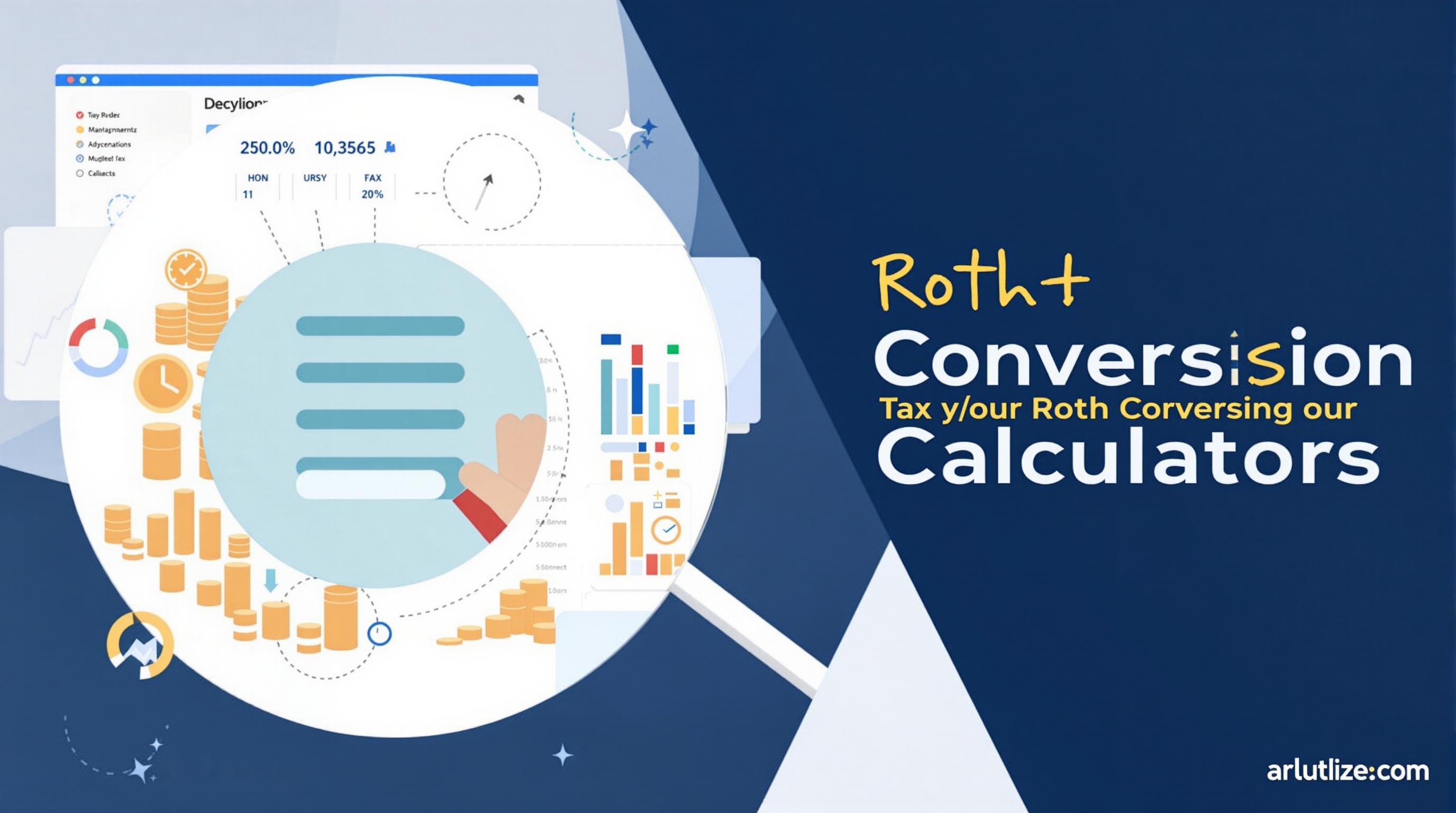Related Articles
- Top 6 Quantitative Hedge Funds Launched Since 2019 That Challenge Traditional Diversification Models
- Top 8 Cutting-Edge Retirement Income Vehicles From the Last Five Years Revolutionizing Financial Freedom
- Uncovering the Role of Behavioral Biases in Roth Conversion Decisions and Their Impact on Long-Term Wealth
- Top 6 Revolutionary Dividend Reinvestment Platforms Launched Since 2019 Redefining Passive Income Growth
- Top 7 Breakthrough Retirement Income Platforms Launched in the Last Five Years Compared and Ranked
- The Untold Influence of Cultural Artifacts on Expanding Investment Horizons and Mitigating Financial Risks
8 Overlooked Roth Conversion Scenarios Impacting Medicare Premiums and Long-Term Care Planning
8 Overlooked Roth Conversion Scenarios Impacting Medicare Premiums and Long-Term Care Planning
8 Overlooked Roth Conversion Scenarios Impacting Medicare Premiums and Long-Term Care Planning
Roth IRA conversions have become a popular strategic move for retirees and those nearing retirement to manage tax liabilities and enhance future financial security. However, the ripple effects of these conversions often extend beyond just tax planning. Particularly, they can impact Medicare premiums and long-term care strategies in ways that are frequently overlooked. Understanding these nuances can make a significant difference in a retiree's financial health and well-being.
In this article, we explore eight less obvious Roth conversion scenarios that can influence Medicare costs and long-term care planning. Each section delves into unique situations that retirees and advisors should consider when navigating Roth conversions to avoid unexpected expenses and optimize benefits.
By examining these scenarios, you'll gain insights that could help refine your retirement strategy, balancing tax goals with healthcare costs and the potential need for long-term care.
1. Increased Medicare Part B and D Premiums Due to Modified Adjusted Gross Income (MAGI) Spikes
Roth conversions increase your taxable income in the conversion year, which can inflate your Modified Adjusted Gross Income (MAGI). Medicare bases Part B and Part D premiums on your MAGI from two years prior, so a larger conversion could temporarily push you into a higher premium bracket.
This means, even though Roth conversions have long-term tax benefits, the short-term impact might be higher monthly Medicare premiums. The Income-Related Monthly Adjustment Amount (IRMAA) surcharges can be substantial, sometimes costing hundreds of extra dollars per month.
To avoid unexpected premium increases, retirees might consider spreading conversions over multiple years or carefully timing conversions in lower income years. Consultation with a financial advisor can help tailor a conversion schedule to minimize IRMAA impact.
2. Roth Conversions and Medicaid Eligibility for Long-Term Care
Medicaid eligibility for long-term care is based in part on income and asset assessments. While Roth IRAs are generally considered countable assets once distributions begin, the conversion process itself can temporarily raise taxable income, potentially affecting eligibility.
A large Roth conversion could cause excess income to disqualify applicants in the conversion year or trigger a penalty period. Furthermore, the strategy of “spend down” assets to qualify for Medicaid must account for the timing and size of conversions.
Understanding the interplay between Roth conversions and Medicaid rules is critical for those who anticipate needing long-term care. Advanced planning with a Medicaid specialist can help manage these conversions without compromising eligibility.
3. Impact on Income Limits for the Qualified Medicare Beneficiary (QMB) Program
The Qualified Medicare Beneficiary program helps low-income individuals by covering Medicare Part A and B premiums. However, eligibility has strict income thresholds that do not always account for one-time income spikes caused by Roth conversions.
A conversion can push your income above QMB eligibility limits for the conversion year, causing a loss of vital premium assistance. This is particularly important for retirees who live near the income cutoff.
To maintain assistance, it’s advisable to carefully calculate conversion amounts or defer conversions until income stabilizes below thresholds. Financial planning that includes QMB eligibility criteria ensures conversions do not inadvertently disqualify needed benefits.
4. Roth Conversions Increasing Taxable Income Affecting Long-Term Care Insurance Premium Deductions
Taxes on Roth conversions can increase taxable income and potentially reduce itemized deductions, including those for long-term care insurance premiums. Since the deductibility of these premiums depends on adjusted gross income, conversions can lead to reduced or phased-out deductions.
This dynamic could result in higher out-of-pocket expenses for long-term care premiums, affecting overall financial planning. Awareness of this relationship helps in optimizing Roth conversion timing to preserve as many deductions as possible.
Consider combining tax planning with long-term care insurance strategies, ensuring that Roth conversions do not unintentionally inflate taxable income and decrease potential deductions.
5. The Effect of Roth Conversions on Required Minimum Distributions (RMDs) and Medicare Premiums
While Roth IRAs themselves do not require distributions during the owner’s lifetime, Roth conversions increase the value of your retirement accounts, potentially affecting the scale of RMDs from other accounts.
Larger RMDs from traditional IRAs or 401(k)s can increase reported income and thus Medicare premiums in subsequent years. Strategically converting funds to Roth accounts early can reduce future RMDs, which may lower premium costs over time.
Balancing Roth conversions against RMD timing is a critical planning element to moderate taxable income spikes and optimize Medicare premium outcomes. Early and incremental conversions often provide the most beneficial results.
6. Roth Conversions and the Impact on Asset-Based Long-Term Care Planning Tools
Advanced long-term care planning sometimes involves asset-based tools like annuities or hybrid insurance products. Roth conversions can complicate these strategies because increased income may affect premium calculations or eligibility criteria.
Converting large amounts to Roth may impact liquidity and the valuation of assets used to qualify or fund certain products. This can alter the terms or feasibility of these insurance solutions.
Coordination between Roth conversion timing and selecting appropriate asset-based long-term care instruments is key to maximizing affordability and coverage.
7. Delayed Roth Conversions and Their Delayed Impact on Medicare Premiums
Some retirees postpone Roth conversions, assuming they will have minimal impact on Medicare costs in the future. However, delayed conversions can cause sudden spikes in income, unexpectedly increasing premiums when they occur.
Procrastination on conversions can also reduce the time for tax-free growth inside the Roth, diminishing the long-term benefits. Conversely, spreading conversions over years mitigates premium impacts and maximizes Roth growth.
Awareness of timing and incremental conversion benefits enables retirees to plan Medicare premiums effectively while optimizing Roth benefits.
8. Coordinating Roth Conversions with Spousal Medicare and Long-Term Care Planning
For couples, Roth conversions should be considered with both spouses' Medicare premiums and long-term care needs in mind. Income combined on tax returns can trigger higher Medicare premiums or affect joint Medicaid eligibility.
A conversion executed by one spouse could inadvertently increase the household income enough to push both past premium or assistance thresholds. Coordinated planning ensures that conversions optimize benefits for both individuals.
Spousal coordination, including staggering conversions or sharing tax burdens, can better protect against unexpected Medicare premium surcharges or long-term care funding challenges.
Additional Considerations and Best Practices for Roth Conversions
Successful Roth conversion planning requires a comprehensive view that balances taxes, Medicare premiums, and long-term care considerations. Retirees should avoid isolated decision-making and instead seek integrated planning advice.
Regularly reviewing income projections, Medicare premium formulas, and long-term care needs helps align Roth conversions with evolving circumstances and regulations.
Engaging both tax professionals and elder law or Medicaid planning experts ensures a holistic approach. This collaboration supports strategic Roth conversions that strengthen retirement security without unintended premium hikes or coverage gaps.
Conclusion
Roth conversions offer significant tax advantages but also affect Medicare premiums and long-term care planning in intricate ways. The eight scenarios outlined here highlight the importance of careful, informed decision-making to avoid costly mistakes.
By understanding how conversions interact with Medicare’s IRMAA rules, Medicaid eligibility, premium assistance programs, and long-term care deductions, retirees can better navigate the complexities of retirement planning.
Ultimately, coordinating Roth conversions with healthcare and long-term care strategies enables the optimization of both tax outcomes and health-related financial protections, fostering greater peace of mind in retirement.
Sources:
Centers for Medicare & Medicaid Services. “Income-Related Monthly Adjustment Amount (IRMAA).” cms.gov
Medicaid.gov. “Medicaid Long-Term Services and Supports.” medicaid.gov
IRS. “Roth IRAs.” irs.gov




